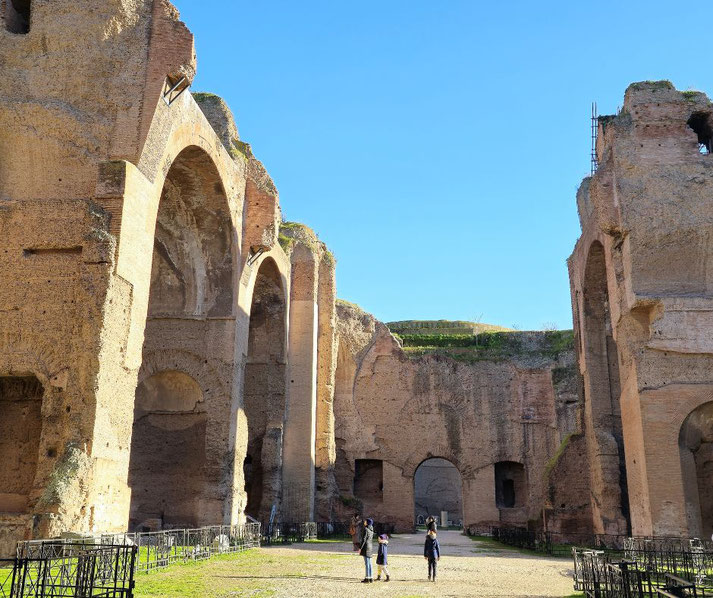The Baths of the Caracalla: the largest surviving Roman baths complex anywhere in the world

Roman architecture aimed to impress, and one of the most incredible public buildings to achieve this as fully were the public baths in Rome.
With their vaulted ceilings, marble-lined pools, and heating systems that seemed to be way ahead of their time, the baths continue to impress visitors with its size and elegance.
By far, the most awe-inspiring of these were the monumental Baths of Caracalla.
The building of the Baths of Caracalla
The construction of the baths began shortly after the assassination of Caracalla’s brother Geta in 211 AD, and was done so for clear political motives.
In fact, it was Caracalla himself that had ordered Geta’s murder, and the emperor followed it with a brutal purge of his supporters.
So, the investment in a large public monument to please the common people of Rome, Caracalla hoped to repair his image and strengthen loyalty among the urban population.
Massive teams of skilled workers who came from Rome’s state-run building corps, a long iwth provincial craftsmen, and they all carried out the work under the direction of imperial engineers.
The project may also have helped distract from the disputed tax policies introduced in the Constitutio Antoniniana, which extended Roman citizenship to most free inhabitants of the empire.
To make his dream a reality, the baths had to have access to enormous volumes of water in order to operate their many pools and fountains.
Therefore, the Aqua Marcia, one of Rome’s oldest and most reliable aqueducts, was extended through a specially constructed branch known as the Aqua Antoniniana.
From there, its waters entered a complex system of settling tanks and holding tanks before feeding into the baths themselves.
Engineers managed to regulate temperature and pressure through a combination of gravity-fed channels and bronze valves.
The site also required a detailed system of underground service corridors, which allowed for the movement of supplies and maintenance crews beneath the complex.

The incredible size and scale of the Baths of Caracalla
The entire complex, including gardens and surrounding structures, covered approximately 25 hectares, while the central bathing facilities could accommodate over 1,500 bathers at any one time.
Within the central building, the sequence of rooms followed a strict layout designed for both practical use and show.
As bathers entered through a grand entrance, they passed into the frigidarium, a cold room measuring roughly 58 metres in length, that the eight massive columns supported, and whose roof was capped by high arched ceilings.
The tepidarium, which was next to this chamber, offered a warm transition space paved with marble and lit by high windows.
Beyond it lay the caldarium, the heated core of the complex, where large metal burners and a high domed ceiling created intense humidity and light.
Because it faced southwest, the caldarium captured the afternoon sun through large glass windows, which added to the interior heat.
Its dome rose over 35 metres high, which rivalled most other monumental Roman spaces in scale.
Other facilities that surrounded the main bathing halls provided a wide variety of other public functions.
For example, two palaestrae provided open-air spaces for athletic exercise, while libraries stored collections of Greek and Latin literature, and lecture halls allowed for both private instruction and philosophical debate.
There were also a series of courtyards filled with water fountains and marble sculptures.
In fact, many of the surviving mosaics depict scenes of athletic competition, sea life, and mythological figures, all chosen to celebrate Roman ideals through imagery.
A large natatio, or open-air swimming pool, anchored the northern end of the complex.

What surprises many modern people is that fact that there was no admission fee, since it was all funded by the emperor, who paid for all of the daily operations and a large numbrer of staff.
Dozens of attendants, slaves, and engineers worked behind the scenes to heat water, clean facilities, distribute oils, and maintain the water systems.
A good example of this is the the hypocaust, which was a floor-based heating mechanism that relied on a constant supply of fuel, air flow, and controlled fire.
As part of this, hundreds of underground pillars lifted the marble floors above a network of heated chambers, which sent heat into the rooms above.
Additional staff ran food stalls, offered massages, and supervised athletic activities.
Why the Baths of Caracalla fell into ruin
Following the decline of Roman authority in the fifth century, the baths slowly fell out of use.
When the Ostrogoths besieged Rome in 537 AD, they deliberately cut the aqueducts that supplied the complex.
Earthquakes and centuries of stone robbing reduced much of the upper structure to rubble.
Yet even through its ruins, the surviving walls, vaults, and fragments give a good indication of just how massive the structure was in its heyday.
Renaissance artists even visited the site to draw inspiration from its scale and proportions.
There were a number of famous sculptures found at the site, including the Farnese Bull and Farnese Hercules, which have since become celebrated examples of classical art in later centuries.
During the modern era, especially in the twentieth century, the site hosted public concerts and performances during summer festivals.
In a way, this keeps alive the structure’s original purpose as a place of spectacle.

What do you need help with?
Download ready-to-use digital learning resources
Copyright © History Skills 2014-2025.
Contact via email
With the exception of links to external sites, some historical sources and extracts from specific publications, all content on this website is copyrighted by History Skills. This content may not be copied, republished or redistributed without written permission from the website creator. Please use the Contact page to obtain relevant permission.





